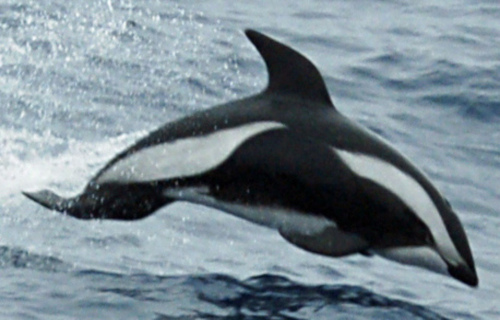
We sincerely hope that you enjoy this article on the Spectacular Dolphins Throughout Our World. Certainly, we enjoyed compiling it for you. Some of these breathtaking cetaceans are among the most well-known, and often best loved, species in the world.
Often the source of stories of their interactions with humans, they inspire many to study the life of our oceans. But not all of the Spectacular Dolphins Throughout Our World are commonly known, of course. Yet all deserve equal attention and care.
Maui Dolphin
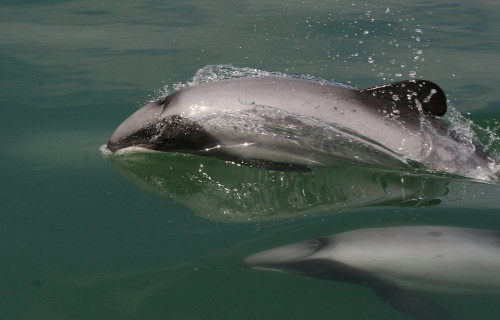
Maui Dolphin Facts
- Leading off our listing of Spectacular Dolphins Throughout Our World is one that holds several distinctions, the Maui Dolphin.
- Above all, this remarkably precious creature truly separates itself from others. That holds true because it ranks as both the rarest and smallest of all known subspecies of dolphin
- However, both it and a related species share an extremely restricted and specific habitat. However, this fact has the end result of leaving them both quite vulnerable
- As a result, officials currently estimate the entire population of this marvelous species to number fewer than 50 individuals
- Given both these very unfortunate facts, the IUCN , therefore, presently lists this variety of dolphin as Critically Endangered
- In addition to the dangers of climate change, the wonderful Maui Dolphin also faces a serious threat from local trawling.

Maui Dolphin Physical Description
The quite amazing Maui Dolphin generally displays a somewhat moderate degree of sexual dimorphism. In this, the remarkable animal remains similar to the great majority of related species.
Therefore, females grow to a slightly larger size than males, averaging 5.6 ft (1.7 m) in length, and about 110 lb (50 kg) in weight.
Although comparatively short, the body of this precious cetacean develops a quite stocky shape. Furthermore, the delicate-seeming snout also displays a gently sloping structure.
Its colorful blend of white, black, and gray markings also gives it a distinctive appearance. However, it is the round dorsal fin that most sets it apart.
So, though small for a dolphin, it remains an impressive creature.
- Kingdom: Animalia
- Phylum: Chordata
- Class: Mammalia
- Order: Artiodactyla
- Family: Delphinidae
- Genus: Cephalorhynchus
- Species: C. hectori
- Subspecies: C. h. maui

Maui Dolphin Distribution, Habitat, and Ecology
To clarify facts, the magnificent Maui Dolphin has only one known range of habitation. To be precise, this range only consists of the waters off the west coast of North Island, New Zealand.
Further, this wonderful mammal also tends to spend most of its time in quite shallow waters. In fact, the depth this gorgeous mammal inhabits rarely exceeds 66 ft (20 m).
Its diet also appears similar to other small cetaceans, usually consisting of small squid, various fish, and random small crustaceans.
Mature females of this species typically bear one calf every 2-4 years, however, beyond that experts know little of this aspect of its biology.
Most importantly, in 2014, the government opened up part of a local sanctuary to oil-drilling, which includes the majority of its endemic habitat.
Risso’s Dolphin
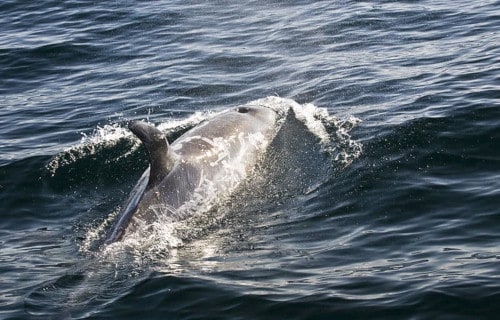
Risso’s Dolphin Facts
- The next one of our choices for Spectacular Dolphins Throughout Our World is the remarkable Risso’s Dolphin.
- The term serves as the common name for the rather adorable Grampus griseus. It’s not only pleasing to the eye, it also ranks among the largest of all known types of dolphin.
- However, and quite unfortunately, the animal has not been widely studied. This regrettable fact occurs due to its strong preference for inhabiting deep ocean waters. This makes studying it difficult.
- Further, people, including scientists, once thought this incredible variety of dolphin to be quite rare. This held true because of the simple fact that sightings of it occurred extremely rarely.
- Thankfully, evidence now indicates that it remains (surprisingly, given man’s hunting habits) present in great numbers. Furthermore, it appears to be present throughout many of the world’s oceans.
- Finally, as many as 30,000 of the Grampus griseus appear to inhabit one specific area alone. That region consists of the ocean waters adjacent to the coast of California, United States.

Risso’s Dolphin Physical Description
Firstly, sexual dimorphism is present among the Risso’s Dolphin, but only to a small extent. The males grow slightly larger, attaining a length of as much as 12.5 ft (3.8 m). These sometimes weigh as much as 1,100 lb (500 kg). However, these average only about 659 lb (300 kg).
The flippers also grow comparatively long and slender in shape. The head is also much more rounded than that of most dolphins. Further, it has a distinctive crease in the sonar-detecting organ known as the melon.
In addition, its natural coloring shows primarily a dark gray. However, adults often display extensive white patches. These occur as a result of scarring from encounters with prey and potential predators.
- Kingdom: Animalia
- Phylum: Chordata
- Class: Mammalia
- Order: Artiodactyla
- Family: Delphinidae
- Genus: Grampus
- Species: G. griseus
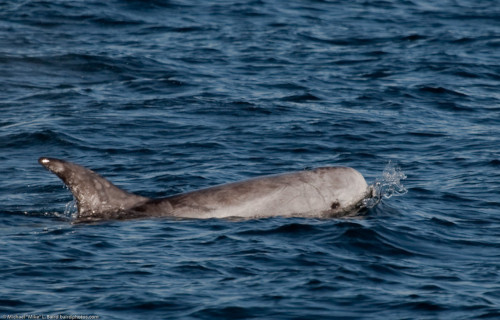
Risso’s Dolphin Distribution, Habitat, and Ecology
Firstly, the truly fascinating Risso’s Dolphin primarily inhabits the warm waters of the world. The impressive animal also appears to primarily inhabit regions near continental shelves.
The Grampus griseus seems to be a long-lived cetacean species, compared to other, related species. As a result of this longer lifespan, many individuals appear to live as long as 40 years.
Additionally, a typical group of this type of dolphin (known as a pod) usually contains as many as 30 individuals. Yet, some super-pods occasionally contain as many as 4,000 specimens.
It will also feed on a wide variety of fish species, being opportunistic in nature. However, its favorite prey is small species of squid, also native to most of the areas that it inhabits.
Finally, though information is scarce, the Risso’s Dolphin appears to have few natural predators itself.
White Beaked Dolphin
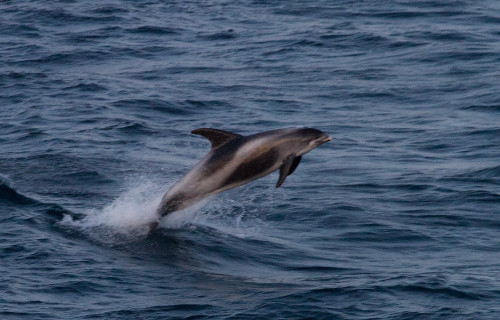
White Beaked Dolphin Facts
- Placing next among these Spectacular Dolphins Throughout Our World is the awesome White Beaked Dolphin.
- Firstly, the stunning mammal was first recognized as separate species in 1846, by the famous taxonomist John Edward Gray. It was also, in fact, one of the first known species in its genus.
- A great deal of mystery still surrounds this endearing ocean creature, however. Marine biologists know almost nothing about either the life expectancy or breeding patterns of the animal.
- Finally, the truly amazing animal’s population numbers appear stable for the moment. However, many consider it to be at risk due to the effects of climate change on its specific habitat.

White Beaked Dolphin Physical Description
The White Beaked Dolphin represents a medium-sized species of dolphin. It attains a maximum length of roughly 10 ft (3.1 m) and may weigh as much as 780 lb (354 kg). The cetacean also has the longest flippers of any known dolphin.
The upper body and flanks also typically display a dark gray, with patches of lighter gray. The underside is a light gray or off-white.
The beak is typically white, hence the name, though it may grow darker with age. That same beak also measures up relatively short, in comparison to other dolphins.
The calves are born with several whiskers on their upper lip, but these disappear as they mature.
- Kingdom: Animalia
- Phylum: Chordata
- Class: Mammalia
- Family: Delphinidae
- Genus: Lagenorhynchus
- Species: L. albirostris
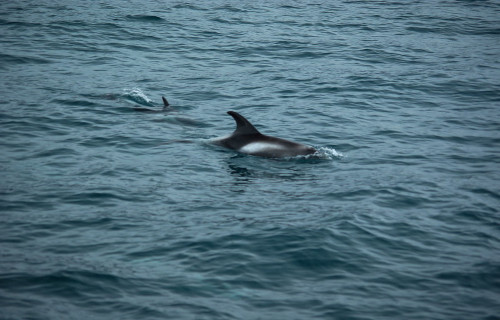
White Beaked Dolphin Distribution, Habitat, and Ecology
The lovely White Beaked Dolphin evolved into an area that includes the subarctic and colder temperate sections of the North Atlantic Ocean. This range also extends from Cape Cod to southern Greenland, Iceland, and to Svalbard.
It also inhabits the upper layers of the ocean and normally stays at depths of less than 3,300 ft (1,000 m). This dolphin evolved as rather social, and usually travels in groups of 8-10 individuals.
Further, its diet primarily consists of small fish and includes haddock and cod. People have even seen the animal feeding alongside orcas.
It is also an especially relevant fact that the species is now protected by the Agreement on the Conservation of Small Cetaceans of the Baltic, North East Atlantic, Irish and North Seas (ASCOBANS).
False Killer Whale

False Killer Whale Facts
- The fourth entry on our list of Spectacular Dolphins Throughout Our World is one that may surprise many of our readers, the False Killer Whale.
- Despite the common name, the False Killer Whale is a member of the Blackfish group. Thus, the remarkable animal isn’t a whale at all. This impressive ocean species actually represents one of the largest members of the dolphin family.
- This species also exhibits the same spirit of playfulness that the smaller and better-known dolphin species do. As a result of this behavior, it remains the only member of its group to ride bow waves on a regular basis.
- However, due to its depredation of fishing lines, it continues to be routinely hunted in parts of its endemic range. Additionally, this predominantly occurs in Japan, where it, unfortunately, remains the target of organized hunting drives.
- Due to such activities, in addition to other dangers, it now faces grave concerns for its future. While the IUCN does include it on the Red List of Threatened Species, its current status remains Data Deficient.
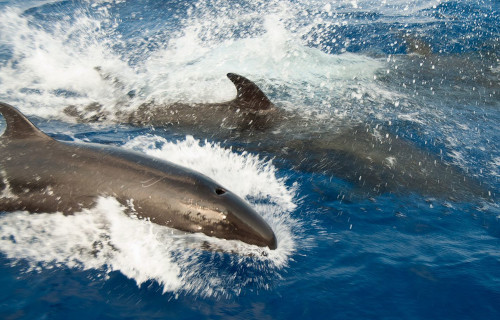
False Killer Whale Physical Description
Firstly, the False Killer Whale, like many related species displays a certain degree of sexual dimorphism. However, in the case of this species, the visible physical difference remains very slight.
Due to this fact, individuals of both genders of this particular species attain roughly the same size. Therefore, each gender typically attains an average body length of about 16.1 ft (4.9 m).
However, exceptional male individuals do tend to attain a greater length and weight. As a result of this tendency, these males sometimes reach a maximum measured weight of 4,900 lb (2,200 kg).
On the other hand, exceptional female individuals may attain a maximum known weight of about 2,600 lb (1,200 kg).
In addition, the coloring typically consists of a pattern of dark gray or black on the upper side and a slightly lighter coloring underneath.
- Kingdom: Animalia
- Phylum: Chordata
- Class: Mammalia
- Order: Artiodactyla
- Family: Delphinidae
- Genus: Pseudorca
- Species: P. crassidens
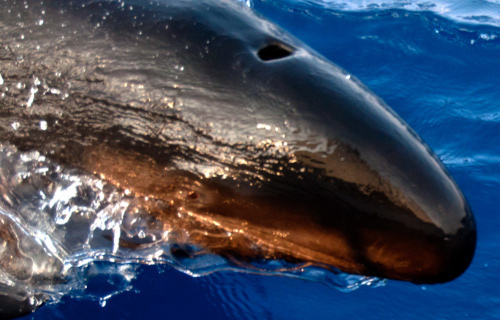
False Killer Whale Distribution, Habitat, and Ecology
Most notably, the magnificent False Killer Whale has a quite broad, yet specific distribution. While it inhabits three separate oceans, it primarily occurs only in the temperate or tropical regions.
The vast majority of individuals tend to appear on the surface. However, it typically inhabits regions with a depth greater than 3,300 ft (1,000 m). Why it does this continues to remain a mystery to researchers.
Further, like all dolphins, it evolved as a pure carnivore and primarily feeds on fish and cephalopods. Yet small marine mammals will occasionally be taken as well. This usually occurs due to a lack of larger prey.
Additionally, it has a highly social nature and typically inhabits pods of between 10-60 individuals. It also often temporarily joins with pods of other dolphin species, sometimes forming groups of hundreds.
This species reaches maturity at about 12 years of age and has an average lifespan of about 60 years. Sadly, for reasons that remain a mystery, it also ranks among the most common cetaceans to engage in mass strandings.
Irrawaddy Dolphin

Irrawaddy Dolphin Facts
- The next animal we are listing among the Spectacular Dolphins Throughout Our World is perhaps the most unusual looking, the Irrawaddy Dolphin.
- The awesome dolphin is a both truly fabulous, and highly distinctive looking cetacean. Sadly, however, the creature also has an extremely disjointed population concentration
- Sir Richard Owen first identified this fascinating mammal back in 1866. But, at that time, the amazing creature was believed to be, and thus misidentified as, a member of another species
- This mistake occurred due to an extreme similarity in physical appearance between the mammals. As a result, the two species were not recognized as separate and distinct until 2005
- Because of its scattered population, scant numbers, and interactions with humans, the IUCN currently lists it as Endangered.
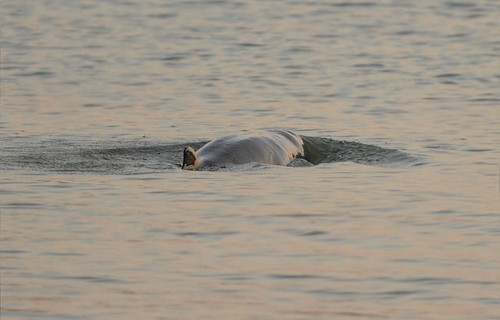
Irrawaddy Dolphin Physical Description
Unlike many mammals, the truly remarkable Irrawaddy Dolphin displays no noticeable signs of sexual dimorphism. This fact further makes it one of the few cetaceans for which this holds true.
Furthermore, the marvelous mammal remains relatively small compared to other species of dolphin. That’s because this amazing creature only attains an average length of about 7.5 ft (2.3 m).
In addition, its overall coloring is a striking combination of two distinct patterns. These consist of dark gray to dark blue above, and significantly paler on the underside, with no precise pattern.
Also, its flippers grow long and broad compared to related species, while its large head and melon display a decidedly non-prominent beak.
Finally, it has the distinction of being the only known variety of dolphin to possess a blowhole to the left of the midline, opening towards the head.
- Kingdom: Animalia
- Phylum: Chordata
- Class: Mammalia
- Order: Artiodactyla
- Family: Delphinidae
- Genus: Orcaella
- Species: O. brevirostris

Irrawaddy Dolphin Distribution, Habitat, and Ecology
Above all, the extremely distinctive Irrawaddy Dolphin has a truly unusual pattern of distribution. That holds true because of the fact that it inhabits both salt water and fresh water.
In addition, this magnificent animal is also distributed in a widely broken pattern. Further, this unique pattern extends across the coastal Indian Ocean from India to Indonesia, in Asia.
Technically, the remarkable mammal represents a sea dwelling species of cetacean. However, many individuals also inhabit freshwater regions, such as bays, estuaries, and even rivers.
Also, much like related species, it feeds on a wide variety of local species, including small crustaceans, cephalopods, and fish.
Although it typically travels in small groups of 2-3 individuals, occasionally larger groups of up to 25 will group together to hunt.
Hourglass Dolphin

Hourglass Dolphin Facts
- The sixth of our Spectacular Dolphins Throughout Our World is also a very reclusive one, the gorgeous Hourglass Dolphin.
- Firstly, the remarkable mammal remains an extremely rarely encountered variety of cetacean. In fact, only 6 complete specimens of the impressive animal, living or dead, have ever been studied.
- As a result of this rather astonishing fact, scientists have very little reliable physical data about this particular species of cetacean.
- Reasonable deductions about its behavior and ecology come from the widely scattered and limited observations in the wild. However, scientists admit that these are by no means certain.
- Also, since its population remains unknown, the IUCN lists it as a Species of Least Concern, pending further data.
- Finally, due to the uncertainty about its numbers, all hunting of this animal is thankfully prohibited by international law.

Hourglass Dolphin Physical Description
Most notably, the Hourglass Dolphin represents a relatively small species of cetacean. The average length of the very few individuals studied, who appeared to be adults, was roughly 6 ft (1.8 m).
Also, in color, these beautiful creatures principally appear black, with large white or gray stripes on the sides and stomachs.
In addition, the marvelous pattern creates the impression of an hourglass. This therefore serves as the source of the common name. Furthermore, the average weight of this remarkable dolphin equals about 250 lb (113 kg).
Its body shape also seems stout in relation to most of its relatives.
Researchers believe that the trait of sexual dimorphism is present in this species. The males are likely slightly smaller and lighter than the females. However, the scientists admit that this remains only a supposition.
Also unique among dolphins, the length of the dorsal fin varies greatly between individuals.
- Kingdom: Animalia
- Phylum: Chordata
- Class: Mammalia
- Order: Artiodactyla
- Family: Delphinidae
- Genus: Lagenorhyncus
- Species: L. cruciger

Hourglass Dolphin Distribution, Habitat, and Ecology
Perhaps the most astounding fact about the Hourglass Dolphin is its territorial range. That’s because the rather amazing mammal appears to possess a primarily circumpolar distribution.
Due to this fact, the farthest north its has ever been reliably sighted is the southern Atlantic Ocean. Further, and more specifically, most of the sightings occurred in the vicinity of New Zealand.
It also appears to be primarily a pack animal, like many related species tend to be. As a result, in the majority of sightings, specimens have been traveling in small groups. These typically consist of 5-10 individuals.
The Hourglass Dolphin is also a carnivore by nature, as remains true for all known dolphins. Additionally, its primary diet appears to be a wide variety of small fish, squid, and crustaceans.
Its natural predators remain unknown, though the Orca is the most likely candidate for this.
Finally, to date, the breeding patterns of this animal and lifespan remain a mystery.
Pantropical Spotted Dolphin
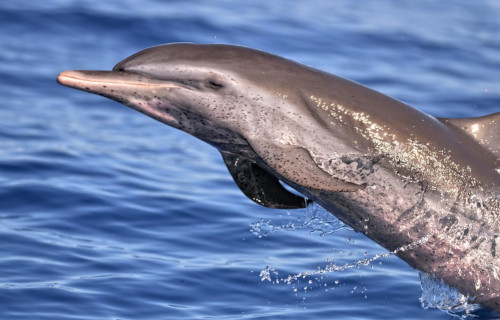
Pantropical Spotted Dolphin Facts
- Out of all of these Spectacular Dolphins Throughout Our World, the Pantropical Spotted Dolphin has perhaps the widest range of them all.
- That’s because it lives in every temperate and tropical ocean. The species was once grouped with the Atlantic Spotted Dolphin but now lists as a separate species.
- Yet this beautiful creature was also once endangered as millions of became snared in tuna nets. Since then, the adoption of dolphin-friendly tuna fishing measures has reversed that trend.
- Consequently, the amazing Pantropical Spotted Dolphin has become (for now) a thriving species. But, the position remains precarious, and could easily reverse itself if conditions change for the worse.
- Climate change, however, now threatens it, as it does all species, including humans. Conservation efforts to protect it, along with other species, are in place. Yet more steps may be needed.
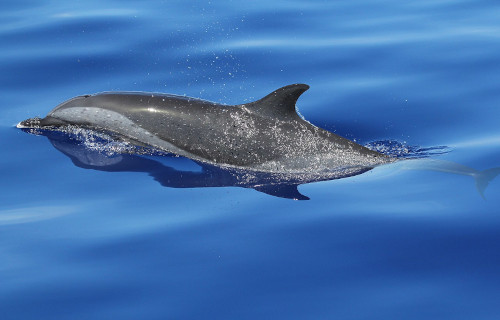
Pantropical Spotted Dolphin Physical Description
The Pantropical Spotted Dolphin does not display and gender-based physical differences. Yet, its appearance does vary across its endemic range. The coastal populations of this species tend to display more spots and are slightly larger.
The average adult length is about 8.2 ft (2.5 m) and the weight is about 265 lb (120 kg). However, exceptional individuals do occur.
The beak is relatively long and rather thin. Also, the throat, chin, and stomach most commonly display pale gray or white.
The coloring of the flanks is also interesting. This is separated into three distinct color bands. The lightest is the bottom band. The middle is darker, and the upper band is almost black.
- Kingdom: Animalia
- Phylum: Chordata
- Class: Mammalia
- Order: Artiodactyla
- Family: Delphinidae
- Genus: Stenella
- Species: S. attenuata
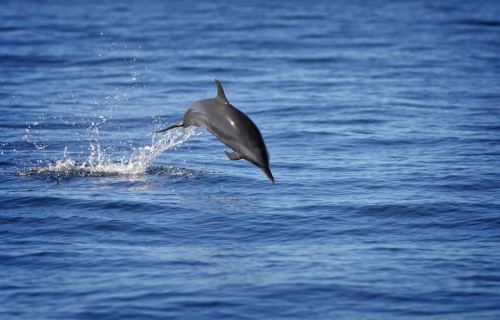
Pantropical Spotted Dolphin Distribution, Habitat, and Ecology
The Pantropical Spotted Dolphin evolved as endemic to all warmer waters. But the animal inhabits some areas more than others. These regions consist of the Atlantic Ocean, Eastern Pacific Ocean, and the Gulf of Mexico.
Further, the global population is estimated at around three million individuals. This makes the prolific animal among the most numerous of all cetaceans. However, experts fear this may change.
This species is also very active and highly prone to great leaps from the water. Individuals also enjoy playing in the wake of large boats. But, this can sometimes prove to be its undoing, due to accidents.
In addition, a typical lifespan for this particular mammal averages about 40 years. Finally, this gentle creature feeds exclusively on a rather wide variety of fish, squid, and small crustaceans.
Dusky Dolphin

Dusky Dolphin Facts
- Next among our listing of Spectacular Dolphins Throughout Our World is another one that refuses to give up its secrets, the Dusky Dolphin.
- Despite its seemingly quite common presence, the marvelous mammal remains a bit of a mystery. People see the animal frequently, so experts presume its numbers to be abundant.
- Yet, no relevant information is available concerning its numbers. Furthermore, it is a protected species but not classified by the IUCN. This occurs due to a lack of available data as to its numbers.
- The mammal also remains popular for its remarkable acrobatics when leaping from the water.
- Sadly, however, numerous individuals frequently become trapped in commercial fishing nets, and perish. Despite its protected status, this, along with climate change, is a serious threat to it.

Dusky Dolphin Physical Description
The Dusky Dolphin is smaller in size than most dolphins. Individuals sometimes reach 6 ft (1.83 m) in length and 210 lb (100 kg) in weight. However, most individuals average less than this.
In color, most individuals tend to appear a very dark gray or black on the top. In addition, the throat and belly of the creature generally display an off-white in color. This makes for a striking contrast in appearance.
There is also no discernible degree of sexual dimorphism. The genders principally vary in appearance only in regards to the dorsal fins. Those of the male usually become broader, with a greater surface area.
- Kingdom: Animalia
- Phylum: Chordata
- Class: Mammalia
- Order: Artiodactyla
- Family: Delphinidae
- Genus: Lagenorhynchus
- Species: L. obscurus
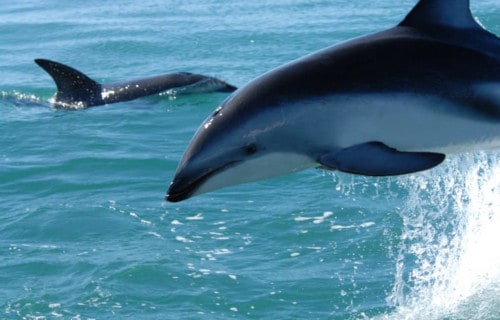
Dusky Dolphin Distribution, Habitat, and Ecology
The Dusky Dolphin primarily inhabits the coastal waters of the Southern Hemisphere. But the distribution is patchy, with major populations scattered. Some exist in South America, New Zealand, southwestern Africa. Others, in southern Australia, Tasmania, and various oceanic islands.
While it also lives offshore, most prefer inshore waters and cooler currents. Moreover, individuals generally prefer the cooler waters near the continental shelf areas of the ocean, as well as around numerous islands.
In addition, many often travel great distances, but there are no discernible migratory habits. The species will frequently associate with other dolphins and various species of whales.
Finally, the Dusky Dolphin commonly consumes a variety of fish and small squid species. Individuals often band together to hunt in unison.
Atlantic Spotted Dolphin
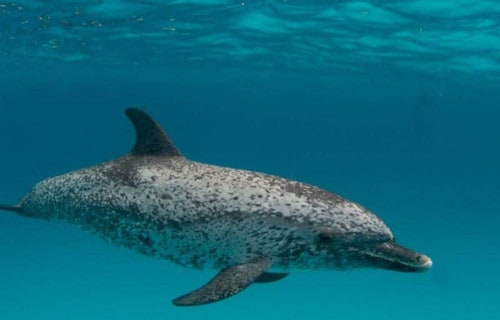
Atlantic Spotted Dolphin Facts
- The ninth entry into our compilation of Spectacular Dolphins Throughout Our World is the marvelous Atlantic Spotted Dolphin.
- This particular species is a comparatively large variety of dolphin. Quite understandably, its name derives from its distinctive mottled coloring. Also, this species was first identified in 1828.
- Pronounced variations in coloring, size, and physical shape occurs between individual specimens.
- Further, its outgoing behavior towards humans has earned it a reputation as one of the friendliest species in any ocean. The animal often follows pleasure craft, seeming to enjoy the company.
- In addition, the species enjoys following commercial fishing vessels, to prey upon discarded fish. This does, however, result in its occasionally being netted themselves.
- Finally, intentional hunting of the dolphin is thankfully no longer legal. The remarkable animal received official protection in 1972.
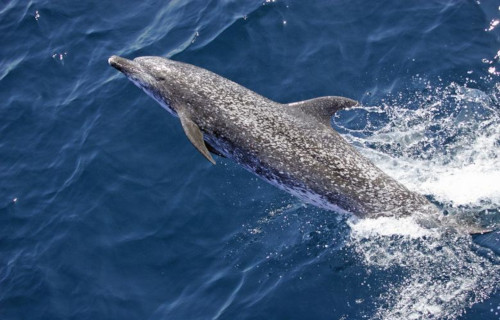
Atlantic Spotted Dolphin Physical Description
The coloring of the Atlantic Spotted Dolphin changes dramatically as the individual matures. Yet, calves are born almost uniformly gray. Further, the species does not display a noticeable degree of sexual dimorphism.
Meanwhile, once weaned, the animal begins to develop the characteristic spots. As it matures, the spots also become darker, denser, and widespread. Elderly specimens will even appear to be black with white spots.
Adults attain an average length of about 7.6 ft (2.3 m). Also, the mammal remains popular for possessing a somewhat chunky body type. Further, an average weight for an adult is roughly 310 lb (140 kg).
- Kingdom: Animalia
- Phylum: Chordata
- Class: Mammalia
- Order: Artiodactyla
- Family: Cetacea
- Genus: Stenella
- Species: S. frontalis
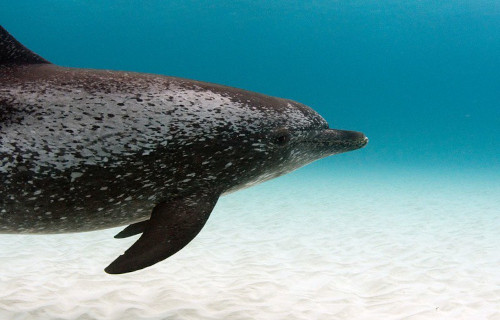
Atlantic Spotted Dolphin Distribution, Habitat, and Ecology
First of all, the beautiful Atlantic Spotted Dolphin has a highly specific and particular habitat. That’s because it typically only lives the warm and tropical waters along the continental shelf of the Atlantic Ocean.
Furthermore, it primarily inhabits a zone ranging in depth from 65-820 ft (20-250 m). But, it can and occasionally does visit significantly deeper waters. This occurs if the scarcity of prey necessitates it.
The mammal also generally travels in groups known as pods which typically range in number from 5-15 individuals. However, larger pods may form temporarily in regions where food is plentiful.
In conclusion, individuals primarily prey upon small fish, invertebrates, and small cephalopods.
Panda Dolphin
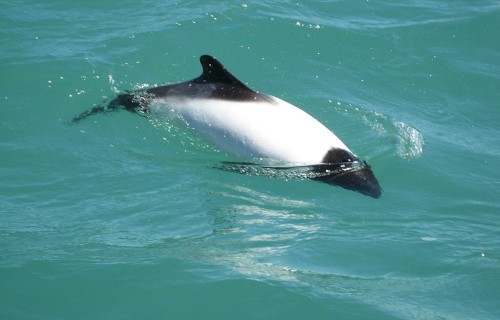
Panda Dolphin Facts
- The tenth of our many choices of Spectacular Dolphins Throughout Our World is the remarkable and fascinating Panda Dolphin.
- Firstly, the Panda Dolphin serves as the common name for the visually quite distinctive Commerson’s Dolphin. Further, this remarkable species is actually divided into two distinct sub-species.
- The mammal was also first described by the French naturalist, Philibert Commerson. This occurred in 1767, subsequent to his sighting of the surprising cetacean in the Strait of Magellan.
- Furthermore, unlike many related species, it appears to still have a stable population. Therefore, the IUCN presently lists it as a Species of Least Concern. However, this could change if climatic deterioration continues unabated.
- In addition to the obvious danger from climate change, it also faces other threats. Quite sadly, its tendency to stay near the shore in its range often leads to its accidental trapping in gill nets.
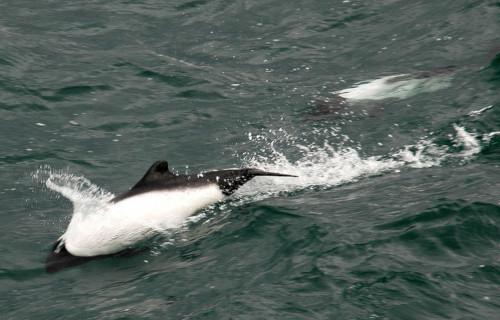
Panda Dolphin Physical Description
Most notably, physical differences understandably exist between the two subspecies of the Panda Dolphin. But, equally understandably, numerous similarities between the two also exist as well.
Firstly, the head, fluke, and dorsal fin appear as black in one subspecies. Also, the rest of the body presents as a bright white. Meanwhile, in the other subspecies, dark parts appear as gray, and the body displays a light gray instead of white.
Additionally, the one with the black markings reaches a length of about 5 ft (1.5 m). The other, however, grows slightly longer. But, though longer, the division between the dark and light sections remains less sharp.
Finally, both subspecies display a small degree of sexual dimorphism. But in its case, it is difficult to spot. That’s because it consists of a difference in the size of black blotch on the stomach. Among males this has a teardrop shape, while on females it appears more rounded.
- Kingdom: Animalia
- Phylum: Chordata
- Class: Mammalia
- Order: Artiodactyla
- Family: Delphinidae
- Genus: Cephalorhynchus
- Species: C. commersonii
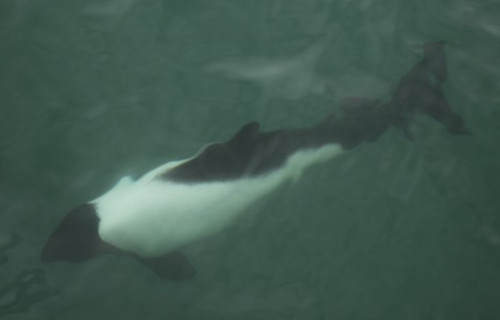
Panda Dolphin Distribution, Habitat, and Ecology
First of all, an unusual distribution pattern exists for the gorgeous Panda Dolphin. That’s because the subspecies each inhabit restricted ranges, situated roughly 2,000 mi (3,200 km) apart.
The more populous of the two lives near South America. More precisely, it inhabits waters near Tierra del Fuego, the Falkland Islands, the Straits of Magellan, and the occasional inlet near the shore of Argentina.
Meanwhile, the other subspecies appears to only inhabit the waters near the Kerguelen Islands. This sits in the southern portion of the Indian Ocean. However, just like the other, it prefers to inhabit the shallow regions.
Further, as is the case with all dolphins, it has a strictly carnivorous diet. Individuals mostly feed on various small fish and squid. However, the animal occasionally supplements this diet with the addition of small crustaceans.
Chilean Dolphin
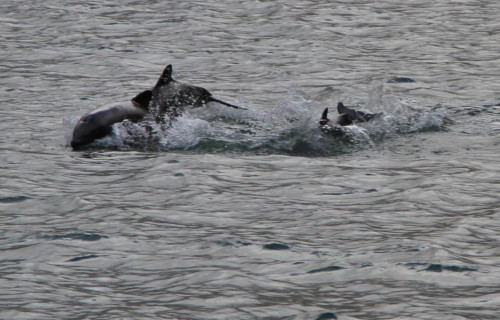
Chilean Dolphin Facts
- The eleventh species selected for inclusion in this article about Spectacular Dolphins Throughout Our World is the awesome Chilean Dolphin.
- First of all, the marvelous Chilean Dolphin stands out from its related species for a variety of reasons. Among those is the quite sad fact that it remains one of the least studied of all known cetaceans. In fact, the majority of what little knowledge scientists have of this magnificent creature comes from the study of deceased specimens, washed ashore.
- The marine mammal also goes by the other common names of the Black Dolphin, and the tonina. Regardless of the name applied to it, this animal represents one of only four species in its genus. Unfortunately, it also constitutes an extremely rare variety of dolphin. That’s because current estimates place its remaining population at no more than 5,000 individuals.
- Furthermore, even this estimate remains uncertain. The actual number may be much smaller. Due to its scant population, highly restricted habitat range, and hunting practices, the IUCN now lists it as Near Threatened. In addition to illegal hunting, which continues, it also faces several other threats to its existence. The dual threats of climate change and habitat loss rank high on this list, as they do for many species today.
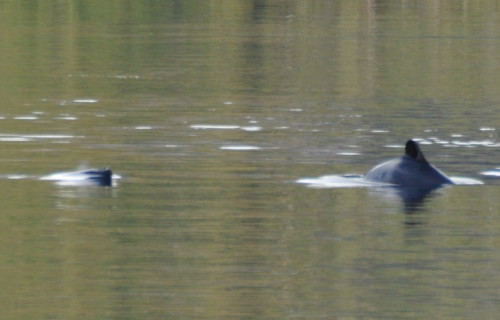
Chilean Dolphin Physical Description
The gorgeous Chilean Dolphin perfectly personifies the principle that beauty comes in all shapes and sizes. That’s because one of the most notable facts about the gorgeous animal remains its sheer physical size. That’s because this beautiful cetacean ranks as one of the smallest of all known types of dolphins.
Mature individuals attain an average length of about 5.6 ft (1.7 m). The animal also boasts an extremely thick body shape. In fact, its girth sometimes equals as much as 65% of its length. In addition, it displays a rather blunt head for a dolphin. Furthermore, its flippers and dorsal fin attain a much smaller size, in relation to body size, than most dolphins.
However, its color pattern remains its most striking feature. The species also displays a very slight degree of sexual dimorphism, in regards to its coloring. The body displays a melange of many shades of gray, which remains the dominant color. The top of the head shows a light gray, while the jaw shows dark, and features a dark band extending to the flippers. Yet, by contrast, the throat displays an off- white color.
- Kingdom: Animalia
- Phylum:Chordata
- Class: Mammalia
- Order: Artiodactyla
- Family: Delphinidae
- Genus: Cephalorhynchus
- Species: C. eutropia

Chilean Dolphin Distribution, Habitat, and Ecology
Quite regrettably, the beautiful Chilean Dolphin appears to inhabit an extremely restricted habitat range. Not surprisingly, as its common name readily suggests, the animal inhabits the waters off the coast of Chile, in South America. Not only does the creature live nowhere else, to our knowledge, but it also does not appear to migrate.
Further limiting its options, the wonderful animal also prefers shallow waters. In fact, it rarely appears in areas with a water depth in excess of 656 ft (200 m). Additionally, it appears to be quite fond of rapidly flowing tidal areas and the mouths of rivers. But, it also likes to spend much of its time in such other locations as bays, channels, and fjords. It even occasionally enters rivers themselves.
This fabulous cetacean is rarely spotted. But, when it does make an appearance, it usually appears in small groups. These typically number from 2 – 10 individuals. Larger groups occur, but only rarely. The Chilean Dolphin primarily consumes small fish, crustaceans, and squid. Unfortunately, researchers known very little about such things as its mating habits. Scientists estimate its average lifespan to be about 20 years.
Hector’s Dolphin
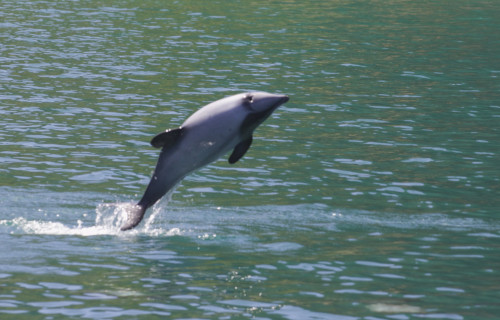
Hector’s Dolphin Facts
- The twelfth entry into this compendium of Spectacular Dolphins Throughout Our World is the incredible Hector’s Dolphin.
- The term itself serves as the accepted common name for a particularly special species of dolphin. Further, it also bears another, more official name. That’s the term for the species more commonly used by most professional researchers.
- However, that’s the hard to pronounce name of the Cephalorhynchus hectori. But, by either name one chooses to use, it remains a special, as well as beautiful, animal. In fact, this stunning animal stands out from its brethren for two separate reasons.
- Firstly, it ranks as the smallest of all known marine dolphins. While distinguishing, this status is of no overall importance. Secondly, it also ranks as the rarest of all its kindred. That status, unlike the first, is indeed of importance to those who love Nature.
- The species derives its common name from Sir James Hector. He examined the first located specimen of the mammal. Nonetheless, he was not the first to scientifically describe it. That honor belongs to the Belgian zoologist, Pierre-Joseph van Beneden.
- Finally, given its scant numbers, along with its limited range, the IUCN currently lists the Hector’s Dolphin as Endangered. This status appears on the organization’s Red List. Not surprisingly, its greatest threats likely consist of habitat loss and climate change.
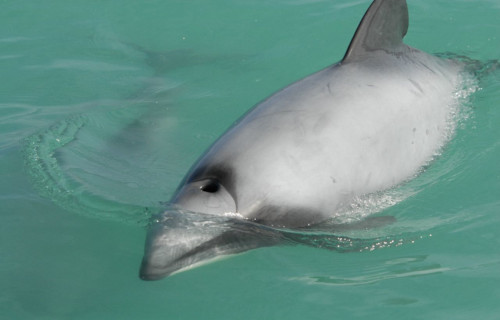
Hector’s Dolphin Physical Description
To simply say that the Hector’s Dolphin evolved as the smallest of all known marine dolphins is an understatement. In point of fact, it remains quite significantly smaller than most, though not all, of them. Yet, the evolutionary reason for this remains undetermined.
Furthermore, like many cetaceans, as well as other creatures, it displays the physiological trait of sexual dimorphism. In its case, this results in the females attaining a larger size than their male counterparts. Yet, the overall variation only equates to about 5 – 7 % difference.
That being said, an average body length for the marvelous creature ranges between 3 ft 11 in to 5 ft 3 in (1.2 – 1.6 m). In addition, the overall body weights also, quite understandably, vary. A typical weight, though, for both genders, equals roughly 88 – 132 lb (40 – 60 kg).
The general coloring is a light gray. Nonetheless, closer inspection reveals the presence of a definite pattern. Its sides and back tend to be light gray. Meanwhile, the flukes, flippers, and dorsal fin appear black. Further, the eyes are surrounded by a black mask.
- Kingdom: Animalia
- Phylum: Chordata
- Class: Mammalia
- Order: Artiodactyla
- Family: Delphinidae
- Genus: Cephalorhynchus
- Species: C. hectori
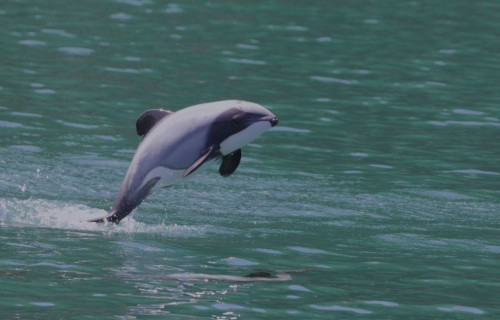
Hector’s Dolphin Distribution, Habitat, and Ecology
The Hector’s Dolphin consists of two subspecies. These are the South Island Hector’s Dolphin, and the Maui Dolphin. Both subspecies share the same habitat range. More specifically, both appear only in the waters around New Zealand.
Though both subspecies live in separate areas, they nonetheless share habitat preferences. These consist of very murky coastal waters at shallow depths. In fact, these beautiful cetaceans rarely appear at depths of more than 330 ft (100 m).
The majority of sightings occurred in areas with depths of less than 160 ft (50 m). The animals also display a slight seasonal variation in this behavior. Thus, most live closer to shore during the spring and summer, and slightly further out the rest of the year.
While the Hector’s Dolphin evolved as a carnivore, its diet remains generalist. But, the choice of prey depends much more on simple size than species. Most if its diet consists of species less than 4 in (10 cm) in length. These mainly consist of small squid and fish.
This creation of Nature itself has few natural predators. Not surprisingly, the few it does have likely come as no surprise. That’s due to the fact that only various sharks and the Orca prey on this mammal with any degree of frequency.
It lives in small groups called pods. For the Hector’s Dolphin, these generally consist of about 5 individuals. Typically, these small groups consist of the same sex. Larger groupings generally contain both sexes, both are usually temporary.
Spectacular Dolphins Throughout Our World

We sincerely hope that you have enjoyed this article on Spectacular Dolphins Throughout Our World. These, and their kin, represent some of the most amazing creatures on earth. They are also among the most popular with humans, which can sometimes be to their detriment. It is up to us to do all that we can to protect and preserve them. After all, Spectacular Dolphins Throughout Our World only applies if they survive.
Check out our other articles on Sensational Spiders Around the World, Native North American Mammals, Breathtaking Asian Species, Wonderful Wild Cats of the World









Leave a Reply